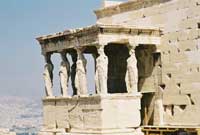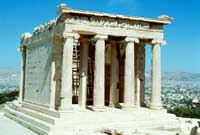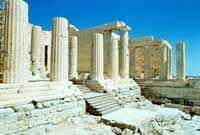 |
| The Acropolis Hill of Athens, also called the "Sacred Rock", is the most important ancient monument of Europe. At the
center of the Athens Acropolis, the Parthenon tower stands proudly over the modern city of Athens and reminds us that Athens, despite its actual appearances, was once one of the greatest civilization
ever... The Acropolis and the white pentelic marble of the Parthenon's tower can be seen from almost every part of Athens and it is the ultimate achievement of the city classical and architectural glory. |
|
| HISTORY
Athens
Acropolis was first inhabited in the Neolithic period. It was first a military fortress as it was located in a strategically position with view towards the land and the sea.
It first became a religious center for the worship of the goddess Athena, during the Mycenaean era.
The place was also used as a residential area until the late 6th century
B.C. when a Delphic oracle declared that the |
|
 |
|
| place should be the province only to the gods. During the classical period (450-330 B.C) three major in importance temples were erected on the ruins of earlier ones: the Parthenon, the Erechteion and the Temple of Nike, dedicated to Athena Parthenos, Athena Polias, and Athena-Apteros Nike.
The Athens Acropolis finally took the form it has today when the Persian destroyed it during the famous battle of Salamina (Salamis) in 480 B.C.
Pericles, the man who established democracy in Athens, rebuilt the Acropolis into a city of Temples considered as the ultimate classical Greek achievement in term of architecture and sculptures.
Since then, the Acropolis has changed many hands and it reflects the different periods of the city of Athens.
The Christians of Byzantium turned the Parthenon into the church of Agia Sophia. Then, in 1205, the city was dominated by the Frankish who gave the hill his originally role of fortress and residence for the Frankish nobles. The Parthenon was turned into a Catholic church named "Notre Dame d'Athenes". After, during the Ottoman occupation starting in the 15th century, the Parthenon was turned into a mosque.
After the independence of Greece from the Turks, one of the first tasks of the newly built Greek State was the conservation of the monuments. This effort of conservation continued until today.
The most important monuments on the Acropolis are: |
|
 |
|
The Parthenon
The building: The Parthenon is the most important and famous monument of
Athens Acropolis and even of all the Ancient Greek civilization. The temple is dedicated to Athena Parthenos (the virgin), the patron goddess of
Athens and the name "parthenon" means "virgin's apartment". |
|
| The temple is located on the highest part of the Acropolis. It was designed by the architect Iktinos and Kallikrates and was built between 447 and 432 B.C. during the Periclean project. The supervisor of the whole work was
Pheidias, the famous Athenian sculptor. The temple is built in the Doric architectural style and in Pentelic marble. The temple consisted of 8 Doric columns on each of the narrow sides and 17 columns on each of the long sides. The lines of the temple were curved in a special way in order to give an optical illusion that gives the impression that the foundations are straight.
The central part of the temple, in front of a pool of water, stood a 40 foot ivory and gold statue of Athena.
The decorations:
The decorations of the Parthenon are considered as unique masterpieces. It is a combination of the Doric metopes and the Ionic frieze on the walls of the
cella.
The metopes, on the east side, depict the Olympian gods fighting against the giants, on the west side, the Lapiths battle the centaurs, on the east side, the triumph of the Greeks over the Amazons while the north side depict the triumph of the Athenians over the Trojans.
The relief frieze runs along the four sides of the temple and depicts the Procession of the Panathenaea, the most important religious festival of ancient Athens. The frieze includes figure of gods, beasts and some 360 humans.
The two pediments of the temple represented major mythological scenes: the east pediment represents the birth of Athena and the west pediment, the fight that took place between Athena and Poseidon for the name of the city.
The Parthenon was the victim of many transformations, depending of what civilization was ruling the city. The final destruction took place in the beginning of the 19th century when the British ambassador in Constantinople, Lord Elgin, stole the decorations of the Parthenon and sold them to the British Museum where they are still exhibited. |
|
The Erechteion
The Temple is built on the part of the Athens
Acropolis that was considered the most sacred for it was a sanctuary where the cults of Athena, Poseidon and Erechtonius took place. It is named after
Erechtonius, a mythical snake-bodied king of Athens killed by Poseidon in a battle for the city patronage. |
|
 |
|
| The Temple is located around the northern portico of the Parthenon; it was part of
Pericles' plan for the Acropolis but the project only started (because of the Peloponnesian Wars) in 421 BC and ended in 406 BC.
The Erechteion is considered as the supreme example of Ionic architecture. It consists of three different dimensions basic parts which are the main temple, the northern and the southern porches.
The main temple is divided into two cellae, one dedicated to Athena, the other to Poseidon, as a reconciliation of the two gods after their contest for the city's name.
The northern porch consists of six Ionic columns and has a propylon. It leads into the Temenos of Pandrossos where Athena's sacred olive tree grew.
The southern porch is the one with the famous six Caryatids replacing columns to support the heavy roof of Pentelic marble. Those beautiful maidens are called Caryatids because the models used for them were women from
Karyes, in Lakonia. |
|
 |
|
The Temple of Athena Nike
This little temple, closed to visitors, is perched on a platform on the south-west edge of the
Athens Acropolis. It was built between 427-424 BC and designed by the architect
Kallikrates. It is an almost square building of Ionic architecture with four Ionic columns at each ends and a frieze representing the conference of gods and |
|
| other mythological
scenes on the east and south sides, and battles scenes on the other sides. Most of the frieze is only fragments remain; parts of it are in the Acropolis museum.
A marble parapet surrounded the platform; it was decorated with sculptures relief now exposed in the Acropolis museum, like the beautiful representation of Athena Nike (Victory) fastening her sandal.
The Temple of Athena Nike used to house a statue of the goddess Athena who was holding a pomegranate, symbol of fertility, in her right hand and a helmet, symbol of war, in her left hand.
The temple has been rebuilt twice: once after the Turks dismantled it in 1686 and once after 1936, when the platform crumbled. |
|
The Propylaea
The Propylaia is the monumental gateway of Athens
Acropolis and is aligned with the Parthenon. It was built during 437-432 BC and designed by Mnesikles. It consists of a central hall with two lateral wings. Each section had a gate which was the only entrances to the Acropolis. |
|
 |
|
| The middle section had a gate opening onto the Panathenaic Way while the western portico was really imposing, with six double columns which were Doric on the outside and Ionic on the inside. The northern wing was decorated with painted panels and was used as a picture gallery (the
"Pinakotheke").
The south wing was the antichamber to the Temple of Athena Nike and the ceiling of the Propylaea's central hall was painted with gold and
colorful decoration. The building was badly damaged in the 17th century by an explosion in a Turkish gunpowder store and, in the 19th century, Heinrich Schliemann removed one of its appendages. Reconstruction and restoration of the Propylaea started in 1909 and still continues.
Other elements of Athens Acropolis:
The Panathenaic Way
During the Panathenaia, festival venerating the goddess Athena, The Panathenaic Way was the route taken by the Panathenaic procession. It was cutting across the middle of the Acropolis, beginning from the Keramikos and ending at the Erechteion. The Great Panathenaic Festival consists of dances, athletic, dramatic and musical contests. The procession was effectuated on the final day of the festival and was composed of men carrying animals for sacrifices to Athena, of maidens carrying drinking vessels (call rhytons), musicians and girls holding the sacred shawl call "peplo". The procession ended when the girls placed the peplo on Athena Polias' statue, in the
Erechteion.
The statue of Athena Promachos
On the left side of the Panathenaic Way are the remains of the foundations of the statues which used to board the path in ancient times. One of those pedestals, 15m from the Propylaea, is the foundation where the gigantic statue of Athena Promachos (champion) used to stand. This 9m-high statue had been made by Pheidias to symbolize the Athenian invincibility against the Persians. That is why the famous sculptor represented the goddess holding a shield in her left hand and a spear in her right one.
In 426 AD, the statue was taken to Constantinople by Emperor Theodosius and destroyed, in 1204, by the inhabitants of the city who believed that the statue was the cause of the invasion of the crusaders.
The Southwest Slope of Athens Acropolis
This area of the Acropolis played an important role in ancient Athens for it was where public building were built to carry out the major artistic, spiritual and religious activities of the city. Here are the most important monuments standing on this area:
The Theatre of Dionysos
In 1838, the Greek Archaeological Society started excavations in Dionysos's sanctuary and brought to light the enormous theatre of
Dionysos. The preserved ruins of the 5th-century theatre built in stone and marble by Lycourgos indicates the extensiveness of the site: the auditorium had 17 000 seats of which only 20 survived. The relief at the rear of the stage date from the 2nd century BC and represent Dionysos' exploits but most of the figures are headless.
The only two figures still having a head are those of the so called "selini", worshippers of the mythical Selinos, Dionysos' mentor, who was the debauched father of the famous satyrs.
During the golden age, the annual Festival of the Great Dionysia, introduced in the 6th-century AD by the tyrant Peiseistratos, was one of the major events of the year. Politicians would sponsor dramas and comedies by writers like Aristophanes, Aeschylus, Euripides and Sophocles and people would come from all around Attica to enjoy the plays and the different festivities.
Roman also used the Theatre of Dionysos for state events, ceremonies and performances.
The Temple of Thrasyllos
It was erected in 320-319 BC by Thrasyllos, standing on the "katatome", the great rocky artificial evened out vertically when the Theatre of Dionysos was been constructed. The Temple has been destroyed; the only remains are two Ionic columns standing above the lovely, tiny Chapel of Panagia Hrysospiliotissa (our Lady of the Cavern) that occupies a small grotto in a cliff behind the Theatre of Dionysos.
The Stoa of Eumenes
West to the Theatre of Herodes Atticus, beneath the Asclepion, is the stoa of Eumenes, a long colonnade built by the king of Pergamos, Eumenes II (197-159 BC). It was built of conglomerate, poros stone, Hymettian and Pergamene marble and was a shelter and promenade for the theatre's audiences.
The Theatre of Herodes Atticus
This architectural marvel is an Odeion built in AD 160 by a wealthy Roman called Herodes Atticus, in memory of his wife Regilla. It is a semicircular theatre of a 38m radius. It could seat 5000 spectators (on marble seats) and the scene was decorated with architectural elements. It was partly demolished by the invasion of the Herulae in AD 267, then excavated in 1857-58 and restored in 1950-61.
The Theatre of Herodes Atticus is still used for drama, music and dance performances during the summer Athens Festival during which famous performers and artists come from all over the world. The Asklepieion
The excavations of the Asklepieion were made by the Greek Archaeological Service.
It is located on the left top of the wooden steps leading to the Theatre of Dionysos. It was built after 420 BC to worship the physician Asklepios, son of Apollo. The Asklepieion consists of foundations of the Temple of Asklepios, a Doric stoa used as the "katagogion", an Ionic stoa dating from the end of the 5th century BC and an altar. |
|
|
 |
|
|
|